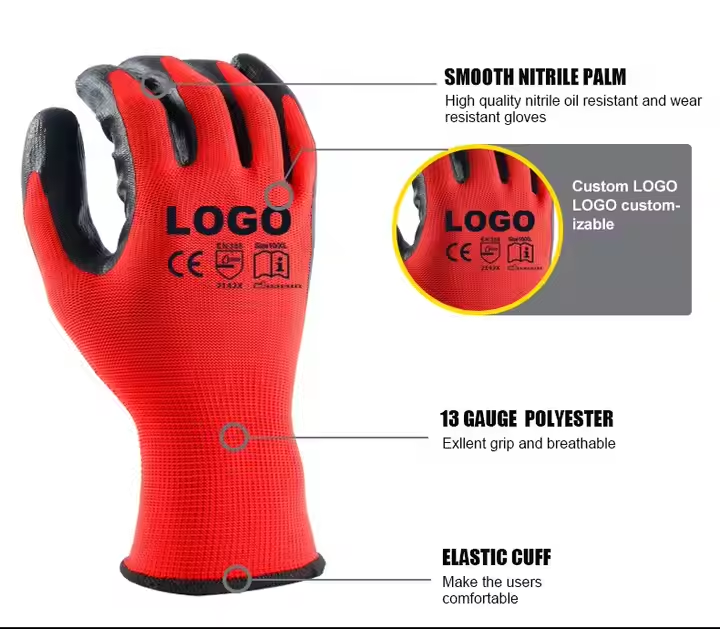
Finding high-quality protective gloves can feel overwhelming. With so many options on the market, how do you know which gloves truly deliver on safety, durability, and comfort?
The quality of protective gloves can be judged by evaluating their materials, certifications, and performance in specific use cases.
Let’s uncover the key aspects to consider, from certifications to real-world performance, so you can confidently select the best protective gloves for your needs.
How do you evaluate gloves?
Evaluating gloves goes beyond just looking at their price. It involves analyzing key factors like material, construction, and intended use.
To evaluate gloves, examine their durability, material quality, certifications, and suitability for specific tasks.

Understanding Materials and Construction
The material and build of a glove determine its overall performance. Common materials include:
- Nitrile: Known for chemical resistance and durability.
- Leather: Ideal for heavy-duty tasks like welding.
- Latex: Offers great flexibility but may cause allergies.
- Cut-resistant fibers: Such as HPPE or Kevlar for sharp object protection.
Material Comparison Table
| Material | Best For | Key Features |
|---|---|---|
| Nitrile | Chemical handling | High resistance to chemicals |
| Leather | Heavy-duty industries | Tough and durable |
| Latex | Precision tasks | Elastic and comfortable |
| Cut-resistant | Glass/Metal handling | Prevents cuts and abrasions |
Certifications: A Trustworthy Indicator
Look for gloves with CE certification or ANSI ratings. These labels ensure the gloves meet international safety standards. Gloves rated for EN 388 or ANSI Cut Levels provide reassurance about their cut, abrasion, and puncture resistance.
How do I choose protective gloves?
Choosing protective gloves depends on understanding the hazards of your specific workplace or task.
To choose the right gloves, assess the risks involved, consider material suitability, and check for necessary safety certifications.
Selecting gloves requires balancing functionality and comfort. Let’s explore some practical steps.
Matching Gloves to Your Task
Each task has different risks. Gloves designed for construction may not work for handling chemicals. Here’s how to match gloves to your industry:
- Construction: Look for gloves with grip and cut resistance.
- Chemical industries: Focus on chemical-resistant nitrile gloves.
- Glass handling: Choose gloves with high cut protection.
- General labor: Opt for gloves with a mix of grip and comfort.
Factors to Consider When Choosing
- Durability: Check the glove’s lifespan for your specific tasks.
- Fit and Comfort: Poorly fitting gloves reduce productivity and safety.
- Cost-Effectiveness: Higher-quality gloves often save money long-term.

How do you check safety gloves?
Testing safety gloves is crucial to ensure they meet your expectations and requirements.
Check safety gloves by inspecting for visible defects, verifying certifications, and conducting practical tests.
Visual Inspection: The First Step
Before using gloves, examine them for:
- Tears or punctures.
- Uneven stitching or loose threads.
- Discoloration, which could indicate material degradation.
Certification Verification
Certifications like CE, EN 388, or ANSI ratings validate the glove’s safety claims. Check the packaging or inner labeling for these details.
Practical Testing
Perform small tests to check for durability, grip, and flexibility. For instance:
- Abrasion test: Rub the glove on a rough surface to see how it holds up.
- Flexibility test: Ensure it allows full hand movement.
Common Issues to Avoid
- Overlooking wear and tear after long use.
- Ignoring fit, which can compromise dexterity and protection.
- Relying solely on price without checking actual quality.
What is protective glove rating?
Protective glove ratings are standardized metrics to measure performance in safety-critical areas.
Protective glove ratings classify gloves based on their resistance to hazards like cuts, punctures, and abrasion.
Understanding the Key Ratings
The two most common glove rating systems are:
- EN 388 (Europe): Measures cut, abrasion, tear, and puncture resistance.
- ANSI/ISEA (USA): Focuses on cut resistance with levels ranging from A1 to A9.
Example of EN 388 Ratings
| EN 388 Symbol | Rating Area | Rating Range |
|---|---|---|
| Abrasion | Abrasion resistance | 1-4 |
| Cut | Blade cut resistance | 1-5 |
| Tear | Tear resistance | 1-4 |
| Puncture | Puncture resistance | 1-4 |
ANSI/ISEA Cut Resistance Chart
| Level | Gram Force to Cut | Use Cases |
|---|---|---|
| A1 | 200-499 | Light-duty tasks |
| A3 | 1000-1499 | Medium-level risks |
| A5 | 2200-2999 | High-risk industries |
Why Ratings Matter
These ratings help buyers compare gloves more easily. Instead of guessing, you can rely on scientific measurements to make informed decisions.
Conclusion
Judging the quality of protective gloves starts with understanding materials, certifications, and ratings. By evaluating each aspect carefully, you can ensure you select gloves that meet your safety and performance requirements.
